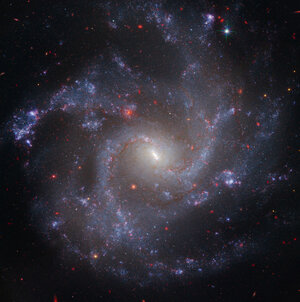Accept all cookies Accept only essential cookies See our Cookie Notice

About ESA
The European Space Agency (ESA) is Europe’s gateway to space. Its mission is to shape the development of Europe’s space capability and ensure that investment in space continues to deliver benefits to the citizens of Europe and the world.
Highlights
ESA - United space in Europe
This is ESA ESA facts Member States & Cooperating States Funding Director General Top management For Member State Delegations European vision European Space Policy ESA & EU Space Councils Responsibility & Sustainability Annual Report Calendar of meetings Corporate newsEstablishments & sites
ESA Headquarters ESA ESTEC ESA ESOC ESA ESRIN ESA EAC ESA ESAC Europe's Spaceport ESA ESEC ESA ECSAT Brussels Office Washington OfficeWorking with ESA
Business with ESA ESA Commercialisation Gateway Law at ESA Careers Cyber resilience at ESA IT at ESA Newsroom Partnerships Merchandising Licence Education Open Space Innovation Platform Integrity and Reporting Administrative Tribunal Health and SafetyMore about ESA
History ESA Historical Archives Exhibitions Publications Art & Culture ESA Merchandise Kids Diversity ESA Brand Centre ESA ChampionsLatest
Space in Member States
Find out more about space activities in our 23 Member States, and understand how ESA works together with their national agencies, institutions and organisations.
Science & Exploration
Exploring our Solar System and unlocking the secrets of the Universe
Go to topicAstronauts
Missions
Juice Euclid Webb Solar Orbiter BepiColombo Gaia ExoMars Cheops Exoplanet missions More missionsActivities
International Space Station Orion service module Gateway Concordia Caves & Pangaea BenefitsLatest
Space Safety
Protecting life and infrastructure on Earth and in orbit
Go to topicAsteroids
Asteroids and Planetary Defence Asteroid danger explained Flyeye telescope: asteroid detection Hera mission: asteroid deflection Near-Earth Object Coordination CentreSpace junk
About space debris Space debris by the numbers Space Environment Report In space refuelling, refurbishing and removingSafety from space
Clean Space ecodesign Zero Debris Technologies Space for Earth Supporting Sustainable DevelopmentLatest
Applications
Using space to benefit citizens and meet future challenges on Earth
Go to topicObserving the Earth
Observing the Earth Future EO Copernicus Meteorology Space for our climate Satellite missionsCommercialisation
ESA Commercialisation Gateway Open Space Innovation Platform Business Incubation ESA Space SolutionsLatest
Enabling & Support
Making space accessible and developing the technologies for the future
Go to topicBuilding missions
Space Engineering and Technology Test centre Laboratories Concurrent Design Facility Preparing for the future Shaping the Future Discovery and Preparation Advanced Concepts TeamSpace transportation
Space Transportation Ariane Vega Space Rider Future space transportation Boost! Europe's Spaceport Launches from Europe's Spaceport from 2012
Galaxy NGC 3370
Amid a backdrop of far-off galaxies, the majestic dusty spiral, NGC 3370, looms in the foreground in this NASA/ESA Hubble Space Telescope image. Recent observations taken with the Advanced Camera for Surveys show intricate spiral arm structure spotted with hot areas of new star formation. Nearly 10 years earlier NGC 3370, in the constellation Leo, hosted a bright exploding star.
In November 1994, the light of a supernova in nearby NGC 3370 reached Earth. This stellar outburst briefly outshone all of the tens of billions of other stars in its galaxy. Although supernovae are common, with one exploding every few seconds somewhere in the universe, this one was special. Designated SN 1994ae, this supernova was one of the nearest and best observed supernovae since the advent of modern, digital detectors. It resides 98 million light-years from Earth. The supernova was also a member of a special subclass of supernovae, the type Ia, the best tool astronomers have to chart the growth rate of the expanding universe.
Recently, astronomers have compared nearby type Ia supernovae to more distant ones, determining that the universe is now accelerating in its expansion and is filled with mysterious 'dark energy.' Astronomers must calibrate the true brightness of type Ia supernovae to measure the true size and expansion rate of the universe. The very nearest type Ia supernovae, such as SN 1994ae, can be used to calibrate distance measurements in the universe, because other, fainter stars of known brightness can be observed in the same galaxy. These stellar "standard candles" are the Cepheid variable stars, which vary regularly in brightness with periods that are directly related to their intrinsic brightness, and thus allow the distance to the galaxy—and the supernova—to be determined directly. However, only the Hubble Space Telescope, equipped with its new Advanced Camera for Surveys, has the capability to resolve these individual Cepheids.
-
CREDIT
ESA -
LICENCE
ESA Standard Licence

A dazzling Hubble collection of supernova host galaxies

Supernovae in NGC 4414

Supernova spotting

Galaxy full of cosmic lighthouses















 Germany
Germany
 Austria
Austria
 Belgium
Belgium
 Denmark
Denmark
 Spain
Spain
 Estonia
Estonia
 Finland
Finland
 France
France
 Greece
Greece
 Hungary
Hungary
 Ireland
Ireland
 Italy
Italy
 Luxembourg
Luxembourg
 Norway
Norway
 The Netherlands
The Netherlands
 Poland
Poland
 Portugal
Portugal
 Czechia
Czechia
 Romania
Romania
 United Kingdom
United Kingdom
 Slovenia
Slovenia
 Sweden
Sweden
 Switzerland
Switzerland

























